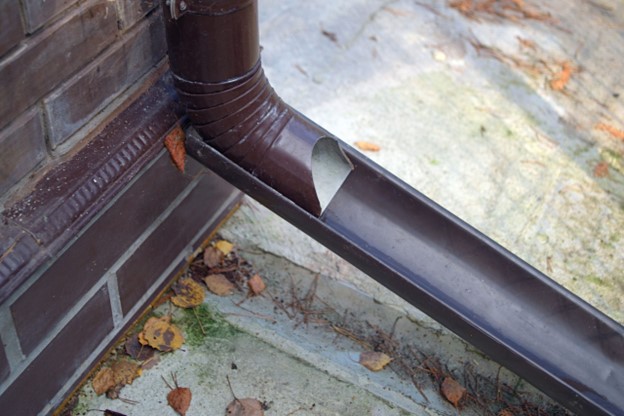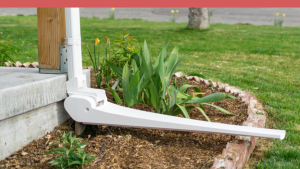Does your home need a downspout extender? If you are like most Americans, your response would be, “What’s that?”
Well, a downspout extender is an essential part of your property’s gutter system. To understand what it is and its importance, think about basement waterproofing. You are constantly looking for the source of water and trying to ensure it doesn’t end up pooling around your foundation or basement. And directing rainwater from your roof away from your home is an effective way to prevent water-related damage to your home.
Did you know in 1,000 sq. feet of roof, about 6,000 gallons of rainwater are produced in one inch of rainfall? That’s right – 600 gallons of water every time it rains just an inch. And that’s only if your roof’s entire footprint is 1000 feet. Scale it up from here, and you will realize that many properties get well over 1,400 gallons of rainwater anytime it rains just an inch.
So where does this water go? Well, we have been dealing with it for over 15 years, watching it flow through gutters and down the downspouts. Sure, installing gutter guards can prevent gutter clogging and ensure seamless water flow. But that’s enough. Your downspouts must be long enough to direct the rainwater away from your home. And that’s where a downspout extender comes in.
Why are Downspout Extenders Important?
Downspout extensions are an important accessory for your home’s gutters. They are add-ons to your gutters designed to allow rainwater to fall to the ground in a controlled way. Then, they divert the rainwater from your home’s siding, foundation, and lawn. Here’s why a downspout extender is a necessity.
1. Reduce the Risk of Foundation Damage
When many property owners hear the words ‘foundation issues,’ they automatically think about changes in soil conditions, poor construction, termite infestations, and natural disasters. However, a common culprit often involves poor drainage. This is especially true if your property has a failing gutter system or doesn’t have downspout extensions.
A single unsuitable being bombarded with rainwater repeatedly can be very risky, especially if that area is your home’s foundation. The excess water can alter the moisture level and weaken the foundation, causing a chain reaction that can harm the entire house.
For instance, concrete – which most Americans forget is porous – can weaken over time due to excess water or moisture. It can become brittle and crack. And that’s not something you want on your foundation. Do you now know why downspouts are not enough to protect your property’s foundation from water-related damage?
After collecting water from your roof, gutters channel that water to the downspouts. If you have added the right downspout extender, the entire system will deposit the rainwater away from your foundation. Without the downspout extensions, this water will be deposited near your foundation, absorbed into the soil, or pooled around the foundation.
2. Protect your Crawlspace and Basement
If rainwater or melting snow pools around your home’s base, you are likely to deal with foundation issues. The pooling water can quickly saturate the soil around your house and exert excess pressure on its foundation. That means the foundation is likely to push inwards and start developing cracks. Also, it can cause the basement wall to bow inwards.
When the soil dries, there’s less pressure on the foundation, and can erode away. The decreased pressure on the foundation allows it to settle. This can easily upset various structures like chimneys and walls, resulting in leaning or unevenness. If rainwater continues around your home, the foundation will continue to weaken and develop more cracks. This can result in worse water-related issues like flooding within the house or mold growth on its walls. Accumulated water can also seep into your crawl space or basement, damaging the inner walls.
3. Prevent Water Damage to your Home
When it comes to the structural integrity of your property, too much rainwater or meltwater is evil, evil, evil. But how? To start with, supersaturated soil around the foundation loses its supportive power. Think of it like a quicksand rather than supportive dirt. At some point, you may need to hire an expert to pier and lift the house to rectify damage caused by excess rainwater around the foundation.
Think of all the rainwater washing down to your foundation – probably because of a poor gutter system or lack of a downspout extender. Visualize the holes, gaps, and voids formed as the water finds its way into your home and the entire house, adjusting to settle and fill those voids under the foundation. And most property owners don’t know such issues can be caused by a single downspout without an extender.
An effective way to avoid such a headache is to prevent the damage long before it happens. Installing gutter guards ensures rainwater and meltwater from your roof can flow seamlessly through your gutter system. Adding the right downspout extenders ensures water can flow away from your home’s foundation. This can reduce the risk of water damage to your home.
4. Save your Home’s Interior
Once rainwater seeps into your foundation or backups in your gutters, it may end up in the interior of your house. And damage possibilities are endless as it streams down the interior and exterior walls. The resulting water stains, damaged carpeting, and soaked wood flooring are all very costly to replace or clean.
Additionally, water within your home’s interior causes more than just rotting and stains. Even when it dries, soft-rotting wood attracts pests like termites. The moist, softwood provides a perfect nest and enough food for these aggravating pests. Termites and rotting wood will compromise the overall structural integrity of your house unless you prevent it.
Mildew and mold growth is another consequence of standing water in your home or around the foundation. Your home’s insulation, foundation, basement, and roof are the easiest places where mold forms. This stuff can grow nearly anywhere there’s excess moisture or standing water. And if you have a failing gutter system or unexpended downspouts.
Let’s emphasize the importance of an effective gutter system in collecting runoff from your home’s roof and relocating it to an area safe for drainage. Without a downspout extender, all the collected rainwater will drain near the property’s foundation. That means all the problems your gutters prevent will not only occur but will be exacerbated.
5. Protection from Water Logging & Erosion
Gutter systems are installed around homes to prevent rainwater from pouring off the roof and landing near the property’s foundation. Once they catch the water, they direct it towards downspouts which lets the rainwater flow out to a safer distance. But without downspout extenders, this water may end up in your lawn, which isn’t good news.
The rainwater flowing out of your downspouts can cause soil erosion. This happens because the rainwater is directed to the ground at a high speed in a small area. If there’s no hard surface like splash blocks to disperse the water, there’s a chance it will erode the soil away.
Similarly, if your downspouts direct water into a limited area where it cannot run off naturally, the area can become oversaturated with rainwater. This will cause grass roots to get moldy and rot. Also, it can cause plant death and yellowing of some shrubs in your lawn. If the area has soft soil, it can get muddy, and you can easily sink into it if you drive over time. Remember, over-saturation can also damage vegetation and attract pests like mosquitoes.
Installing an efficient downspout extender can be a solution to such water-related damage. The downspout extensions can direct rainwater and meltwater from your roof to a safe distance from your home. This will reduce the chances of rainwater pooling in your lawn and causing water oversaturation. Also, installing gutter guards can help prevent clogging. That means your gutters and downspouts will continue to work efficiently.
How to Install a Downspout Extender
The process for installing a downspout extender largely depends on the type of downspout extension you need or want in your home. Here’s a step-by-step process for installing a downspout extender.
Step1: Planning & Preparation
If you’re a handy DIYer, installing a downspout extender can be relatively easy and satisfying. However, planning and preparation is a crucial step. First, you need to choose the downspout extension type that suits your home. The most common extension types include roll-out downspout extenders, flip-up downspout extenders, flexible extenders, underground diverters, and decorative splash blocks.
Other downspout extension ideas include aluminum extensions, plastic downspout extenders, and rain barrel systems. First, choose the right downspout extender based on various factors, such as the slope of the area surrounding your home, local building codes, and your preferences. If you’re not sure of the right downspout extension, consult a professional. For instance, a professional from HomeCraft Gutter Protection may be able to help.
Next, check with your local municipality to find out if you require a permit to install a downspout extender, especially the underground drainage system. If you do, you will need to ensure you adhere to the municipality requirements on rerouting and discharge spots. Also, work with an expert to understand the set regulations and follow them.
If you don’t need a permit, ensure your downspout extension doesn’t create problems for the nearby homes. Remember, effective planning and preparation will ensure your project is successful without creating more issues.
Step 2: Gather the Necessary Materials
It’s crucial to mention that the entire process of installing a downspout extender is quite involved. So, you must gather everything you need before you start the installation process. Suppose you choose to install an underground drainage system as your downspout extender. In that case, you will need a shovel or spade, tape measure, hammer, level, and hacksaw.
You will also need PVC piping or corrugated drain lines (drainage piping). It’s crucial to plan out the joints and lengths you need before purchasing such materials. This way, you can avoid frustration and save time. Still, we emphasize the importance of working with an expert to ensure you acquire the right materials and tools for installing your downspout extender.
Step 3: Mark where the Extender will be laid
Start by marking where the extender must direct the rainwater from your gutter system. Assuming you are installing an underground drainage, you can use outdoor spray paint to delineate the system before you start digging. It’s also recommended to extend the connection to the downspout out about 4 feet from your home before installing joints to direct the drain.
Step 4: Digging
Still, assuming you are still installing underground drainage, you will need to dig a trench. We recommend removing the dirt and placing it on a large tarp or cardboard. This will make it easy to backfill the trench after adding the pipes. Work with an expert to determine the highest point of the trench and ensure you get the slope correct. This way, you will avoid the potential for freezing in your drain lines that are not below the freeze line. Keep in mind that freezing is a problem, as ice dams can easily clog the drain and affect the entire gutter system.
Step 5: Test Fit and connect the Extender to the Downspout
Depending on your preferred downspout extensions, the testing and installation process will take a few minutes to a few hours. Flexible extenders and decorative splash blocks may not require digging. However, an underground drainage system will require you to test-fit your pieces first before the actual installation.
Once you’re sure your system will work efficiently, it’s time to make permanent connections. Be sure to work with an expert to avoid mistakes that will eventually affect the efficiency of your entire gutter system.
Wrapping Up
Does your home really need a downspout extender? Well, for your entire gutter system to protect your home and lawn from water-related damage, your downspouts must drain to an area that’s far enough away from the property. And the most effective way to do so is to install the right downspout extensions.
FAQs
How far should a downspout extend from your home?
At least 4 feet away. This will prevent runoff from causing foundation problems or damaging your lawn. However, some circumstances may require extending the downspouts further, especially if the land slopes towards your home.
How do you extend a downspout?
The entire process of adding a downspout extension isn’t complex. Simple extenders like splash blocks and roll-out sleeves are easy to install. However, complex systems like underground drainage systems may require an expert.
Can downspout extensions help protect homes from water damage?
Yes. Installing gutter guards ensures rainwater and meltwater from your roof can flow seamlessly through your gutter system. Adding the right downspout extenders ensures water can flow away from your home’s foundation. This can reduce the risk of water damage to your home.




